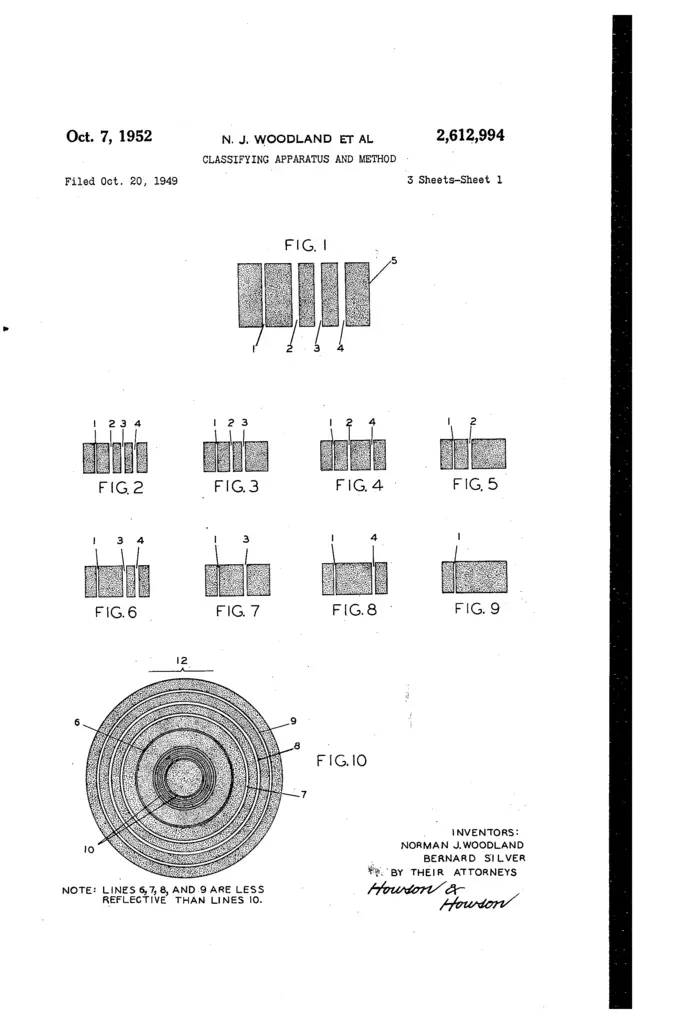The invention of the barcode can be traced back to the late 1940s, and while it can be seen on just about every product today, it wasn’t a commercial success until the 1980s. The first barcode didn’t look like it does today, either.
In 1948, a graduate student at Drexel Institute of Technology in Philadelphia named Bernard Silver overheard a supermarket chain president asking the dean of his college to come up with a better way to speed up the checkout process at his supermarkets. While the dean didn’t act on the request, Silver thought it was an intriguing idea. He told his friend who was an inventor named Joe Woodland about the idea, and Woodland agreed to try to find a solution.
Woodland began working on the problem in 1948 and even left his graduate school to devote time to reach his goal. He came up with a solution in an unlikely place in 1949. While he was sitting on a beach in Miami, he began to think that Morse Code could be the answer. He started to poke his fingers into the sand, but instead of using dashes and dots, he drew out thick and narrow lines. He then made the lines into a circle.
Woodland joined Silver in Philadelphia and began to work on the new system Woodland had discovered in the sand in Miami. They were eventually granted a patent in 1952 for their idea. But the problem became that the technology wasn’t in place to use their new idea. There wasn’t a computer that could process the new code, and there wasn’t a light bright enough that could discern between the black and white bars.
It would be another 20 years before the technology caught up with what the circular barcode was supposed to do. RCA began researching how customers could have their items scanned at a supermarket to speed up the shopping process. The researchers came across the patent for the circular bar code, or “bull’s-eye,” that had been invented by Woodland and Silver in 1952 and decided to use the barcode in their design.
On July 3, 1972, RCA installed an automated check stand at a Kroger grocery store in Cincinnati, Ohio. While the circular barcode proved successful in the one store, in order to be used nationwide, the barcode would have to be universal.
Next came the daunting task of convincing supermarkets and other retailers to all use the same code for a specific product, and no one could agree what that code might look like. It finally came down to seven companies that bid on what the code would be. They submitted their bids to the Symbol Committee, which was a part of the Ad Hoc Committee of the Universal Product Identification Code and the group that was in charge of coming up with a universal barcode for products.
While RCA had shown that the code could be used successfully, a late bid by IBM upstaged their bid. IBM had no technology in place for a barcode checkout system, and they weren’t familiar with the system RCA had implemented. IBM gave the task of coming up with a new bar code to George Laurer. The specifications from the Symbol Committee were that the barcode had to be a specific size and small, it had to use technology that was readily available, and it had to be read from any direction when placed across a scanner.
Laurer came up with the familiar rectangular barcode we know today. His design won over the circular design of the original barcode and was named the Universal Product Code, or UPC. On June 26, 1974, the UPC barcode was used for the first time in Troy, Ohio, at Marsh Supermarket. The first product that was scanned with the new barcode was a pack of Wrigley’s Juicy Fruit chewing gum.
The choice of a pack of gum as the first product to be scanned wasn’t just by chance. Clyde Dawson, the head of research and development for Marsh Supermarket, was the first shopper to use the new scanning system, and he picked the gum because he wasn’t sure that a barcode could fit and be read on a product that was so small.
The pack of gum and the receipt from the transaction are on display in the Smithsonian Institution. It took a while for the UPC to catch on, however, and it wasn’t until the 1980s that the UPC on products became widely implemented.
Sources: Smithsonian, Chicago Tribune, Slate, Inc.com, NY Time



